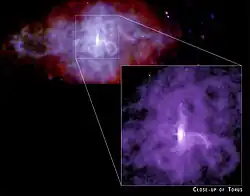 X-ray image of 3C 58 by the Chandra X-Ray Observatory. The pullout box shows the inner toroidal-shaped nebula | |
| Observation data Epoch J2000.0 Equinox J2000.0 | |
|---|---|
| Constellation | Cassiopeia |
| Right ascension | 02h 05m 38s |
| Declination | +64° 49.7′ |
| Apparent magnitude (V) | 8.17 |
| Characteristics | |
| Spectral type | III[1] |
| Astrometry | |
| Distance | 10,000 ly (3067.48 pc) |
| Absolute magnitude (MV) | 3.70 |
| Details | |
| Mass | 1.36–1.52[1] M☉ |
| Temperature | 150,000[1] K |
| Rotation | 65.7159285 ms |
| Age | 3500 years |
| Other designations | |
| Database references | |
| SIMBAD | data |
3C 58 or 3C58 is a pulsar (designation PSR J0205+6449) and supernova remnant (pulsar wind nebula) within the Milky Way. The object is listed as No. 58 in the Third Cambridge Catalogue of Radio Sources.
It is located 2° northeast of ε Cassiopeiae and is estimated to be 10,000 light-years away. Its rotation period is 65.7 ms (so PSR J0205+6449 does not belong to the class of millisecond pulsars).
The pulsar is notable for its very high rate of cooling, which is unexplained by standard theories of neutron star formation. It is hypothesized that extreme conditions in the star's interior cause a high neutrino flux, which carries away the energy so that the star cools.[2][1] 3C 58 has been proposed as a possible quark star, also referred to as a strange star.[3][4]
The age is not well known, and different techniques have given different results on the apparent age. Estimates from the expansion measurements of the filamentary structure in the radio of the synchrotron nebula suggest the age to roughly 7000 years. [5] The proper motion of the expanding optical shell of 3C 58 has been measured three times, always with an age of around 3500 years. Further, a collection of age measures from eight methods returns ages from 2400 to 7000 years.[6] However, estimates from the proper motion of the shell surrounding SN 1181 suggest a much younger age of around 800 years. In addition, a review of the available age estimates in the literature published in 2013 suggested that previous age estimates made with different methods resulted in erroneously large ages as a result of a lack of consideration of the physical properties of the pulsar, and that the older results were also not inconsistent with a younger age less than 1000 years.[7]
Since 1971, 3C 58 has been speculatively connected to the Supernova of 1181 AD, as reported by Chinese and Japanese observers.[8] However, multiple factors such as the age and position of the remnant could suggest that 3C 58 is not the remnant of SN 1181. A different object, Pa 30, was later proposed as an alternative candidate for the remnant of SN 1181, and is believed to be more likely connected. [9]
See also
- RX J1856.5−3754, a possible quark star
References
- 1 2 3 4 5 Yakovlev, D. G.; Kaminker, A. D.; Haensel, P.; Gnedin, O. Y. (2002). "The cooling neutron star in 3C 58". Astronomy & Astrophysics. 389: L24–L27. arXiv:astro-ph/0204233. Bibcode:2002A&A...389L..24Y. doi:10.1051/0004-6361:20020699. S2CID 6247160.
- ↑ "Chandra :: Photo Album :: 3C58". Chandra.harvard.edu. 14 December 2004. Retrieved 21 August 2012.
- ↑ Cramer, John G. (November 2002). "Quark Stars". Analog Science Fiction & Fact Magazine. Retrieved 17 August 2015.
- ↑ "RX J1856.5-3754 (and the 3C58 Pulsar)". www.solstation.com. Retrieved 18 August 2015.
- ↑ Bietenholz, M. F. (1 July 2006). "Radio Images of 3C 58: Expansion and Motion of Its Wisp". The Astrophysical Journal. 645 (2): 1180–1187. arXiv:astro-ph/0603197. Bibcode:2006ApJ...645.1180B. doi:10.1086/504584. ISSN 0004-637X. S2CID 16820726.
- ↑ Fesen, Robert; Rudie, Gwen; Hurford, Alan; Soto, Aljeandro (2008). "Optical Imaging and Spectroscopy of the Galactic Supernova Remnant 3C 58 (G130.7+3.1)". The Astrophysical Journal Supplement Series. 174 (2): 379–395. Bibcode:2008ApJS..174..379F. doi:10.1086/522781. S2CID 120672848.
- ↑ Kothes, A. (2013). "Distance and age of the pulsar wind nebula 3C 58". Astronomy and Astrophysics. 560: A18. arXiv:1307.8384. Bibcode:2013A&A...560A..18K. doi:10.1051/0004-6361/201219839. S2CID 118595074.
- ↑ Stephenson, F. Richard (1971). "A Suspected Supernova in A. D. 1181". Quarterly Journal of the Royal Astronomical Society. 12: 10–38. Bibcode:1971QJRAS..12...10S.
- ↑ Ritter, Andreas; et al. (2021). "The Remnant and Origin of the Historical Supernova 1181 AD". The Astrophysical Journal Letters. 918 (2): L33. arXiv:2105.12384. Bibcode:2021ApJ...918L..33R. doi:10.3847/2041-8213/ac2253.
External links
 Media related to 3C 58 at Wikimedia Commons
Media related to 3C 58 at Wikimedia Commons- Article about 3C58
- What is known about 3C 58
- Image from Aladin